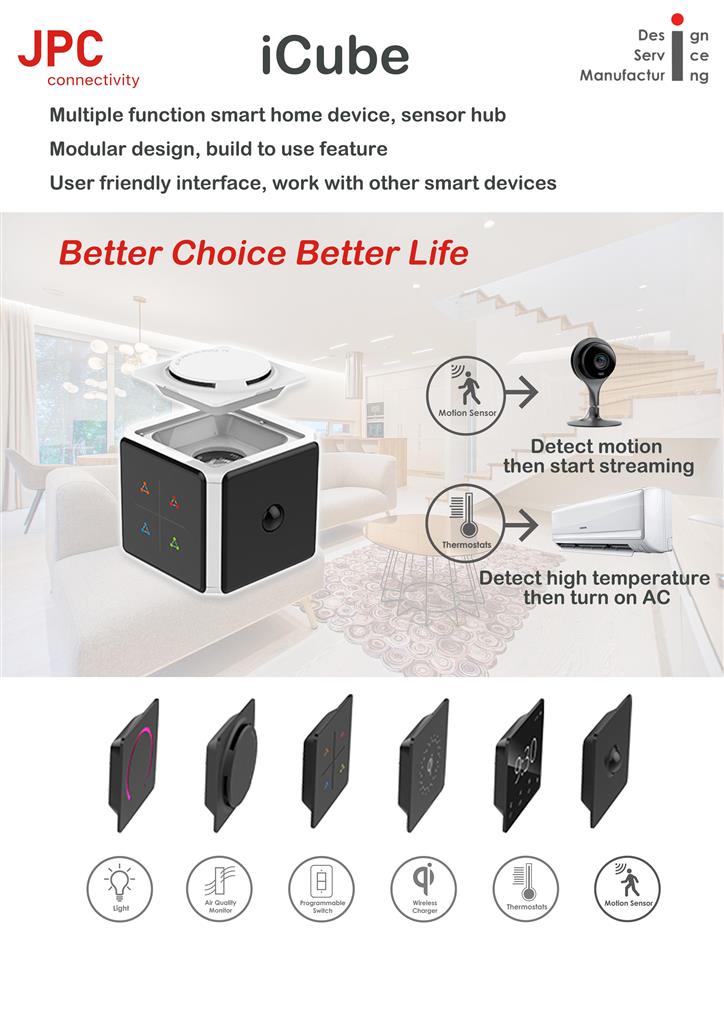JPC Connectivity is well known for its connectors and cables. However, as early as 2000, JPC stepped into manufacturing peripherals like mice and speakers, and then even expanded its product lines to the areas such as wireless charging. Today, JPC Connectivity is solid on the development of consumer IoT products.
Four key techniques support JPC's success in maintaining a stable development of its IoT business for many years. They are wireless interfaces, energy management, sensors, and user experience (UX).
Mastering 4 major niches and strengthening the design capabilities
The wireless interface is always the most critical part of an IoT product. This is why JPC continuously invests considerable huge resources into the development of wireless technologies like Wi-Fi, infrared, Bluetooth, LoRa, and NB-IoT. As for energy management, JPC also keeps a clear focus on improving the charging with high energy efficiency when JPC was developing its first wireless charging stations for smartphones and tablets back in 2007 and 2008.
Even though the market of sensor modules is dominated by the major chip vendors, JPC still keeps the design capability on integrating the wireless parts with sensor components for flexible designs to meet different customization requests. Based on JPC's experience by working with major consumer electronic brands, JPC is highly capable of deriving a thorough understanding of product usage scenarios and creating the optimal user experience which matches best the user needs.
An impressive product portfolio may support the evidence of JPC's success. For example, JPC worked with a major smartphone manufacturer to make the Qi charging docks and phone cases. JPC also manufactured the AC adapters for Russian telecommunication companies, designed the charging docks for name-brand tablets, and produced universal AC/DC adapters for laptops.
JPC was also the first company to be certified by the Windows Media Center. As one of the pioneers in developing Infrared remote controllers, JPC develops products from its proprietary protocols to its modern Bluetooth frameworks. It built a wireless presentation remote controller, which was a multi-function pioneer in the remote market.
From the early days of the 21st Century, JPC has acted mainly as a manufacturer of OEM and ODM products after it steps into the IoT industry.
Innovative technologies enable local smart control sustained when the WAN is offline.
JPC has great experience collaborating with major e-commerce platforms. Not only was JPC one of the first companies to make a bar code scanner that is equipped with both Wi-Fi and Bluetooth, but it was also manufacturing OEM smart buttons and IR blasters to improve the shopping experiences for end customers by creating a convenient smart home way.
Currently, wireless modules, sensor modules, and 2-in-1 wireless accelerometers are the main products of JPC. JPC specializes in making customized proof of concept (POC) prototypes with those modules to help customers to accelerate product development or even to combine them with other products to form complete smart terminal devices.
Recently, JPC also entered the market of consumer devices, such as smart plugs and sensor hubs, which can be used as fundamentals to meet more advanced needs such as the replacement cycle tracking for water filters or the water level detection of fish tank/bathtub.
In addition, the sensor hubs are the pride of JPC, as they adopt a patented "Sensor Cube" technology, which allows for five different sensors to be controlled through one single control board unlike traditional one-to-one sensor control IC chips.
Overall, JPC has a clear R&D focus on sensors as its IoT strategy, which includes both sensors and module products. In the future, JPC aims the vertical integration with smart edge gateways, cloud technology, user interface, and more comprehensive environmental monitoring solutions to move consumer applications onto industrial applications such as smart factories.
The common environmental detection solutions in the industry nowadays rely on the instructions delegated from the cloud. The disadvantage to this approach is that once the device loses WAN connection, the user loses its ability to control peripheral devices, which does not meet the public's expectations of smart control. To overcome this, JPC combines network gateways, AI, and edge computation technology to fulfill meaningful smart control, so the users can keep the control capabilities and applications of smart home or smart factory functions locally the WAN connection is off.
In conclusion, JPC demonstrates its capabilities from design to manufacturing from extensive experience. It plans to leverage its resources to maximize its developing capability and flexibility to build tailored IoT solutions for its customers.

JPC Connectivity continuously enhances the capability on developing IoT products with its solid expertise and experience
Photo: Company



